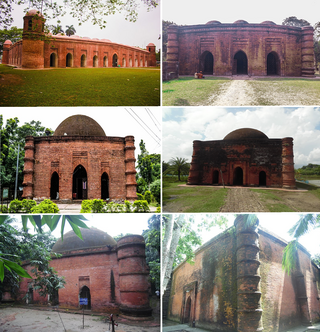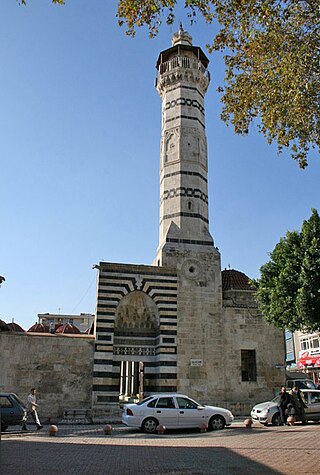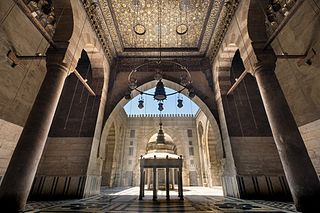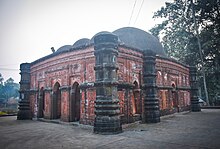
The al-Hakim Mosque, nicknamed al-Anwar, is a historic mosque in Cairo, Egypt. It is named after al-Ḥākim bi-Amr Allāh (985–1021), the 6th Fatimid caliph and 16th Ismāʿīlī Imam. Construction of the mosque was originally started by Caliph al-ʿAziz, the son of al-Muʿizz and the father of al-Ḥākim, in 990 CE. It was completed in 1013 by al-Ḥākim, which is why it is named after him.

The Süleymaniye Mosque is an Ottoman imperial mosque located on the Third Hill of Istanbul, Turkey. The mosque was commissioned by Suleiman the Magnificent and designed by the imperial architect Mimar Sinan. An inscription specifies the foundation date as 1550 and the inauguration date as 1557, although work on the complex probably continued for a few years after this.

The Mosque-Madrasa of Sultan Hasan is a monumental mosque and madrasa located in Salah al-Din Square in the historic district of Cairo, Egypt. It was built between 1356 and 1363 during the Bahri Mamluk period, commissioned by Sultan an-Nasir Hasan. The mosque was considered remarkable for its massive size and innovative architectural components, and is still considered one of the most impressive historic monuments in Cairo today.

The Bayezid II Mosque is an early 16th-century Ottoman imperial mosque located in Beyazıt Square in Istanbul, Turkey, near the ruins of the Forum of Theodosius of ancient Constantinople.

The Mosque City of Bagerhat is a UNESCO World Heritage Site in Bagerhat District, Bangladesh. It contains 360 mosques, public buildings, mausoleums, bridges, roads, water tanks and other public buildings constructed from baked brick. The mosques were built during the Bengal Sultanate in the 15th century, of which the Sixty Dome Mosque is the largest. Other mosques include the Singar Mosque, the Nine Dome Mosque, the Tomb of Khan Jahan, the Bibi Begni Mosque and the Ronvijoypur Mosque. The mosques were built during the governorship of Ulugh Khan Jahan, a Turkic military officer appointed as governor in the Sundarbans by Sultan Mahmud Shah of Bengal.

Binat Bibi Mosque is the earliest surviving mosque in Dhaka built in 1454 by Bakht Binat, the daughter of Marhamat. It was built during the rule of the Sultan of Bengal, Nasiruddin Mahmud Shah (1435–1459). The mosque is located beside the Hayat Bepari’s Bridge in Narinda area.

Ghoraghat is an upazila of Dinajpur District in the Division of Rangpur, Bangladesh.

Manda is an upazila of Naogaon District in the Division of Rajshahi, Bangladesh.

The Great Mosque of Adana, also known as the Ramazanoglu Mosque Turkish: Ramazanoğlu Camii), is a 16th-century mosque in Adana, Turkey. It forms part of a complex (külliye) that includes a madrasah and a mausoleum (türbe). The buildings are on Kızılay street, next to the Ramazanoğlu Hall.

Choto Shona Mosque is located in Chapai Nawabganj district of Bangladesh. The mosque is situated about 3 kilometres (1.9 mi) south of the Kotwali Gate and 0.5 kilometres (0.31 mi) to the south-east of the Mughal Tahakhana complex in the Firozpur Quarter.

The Sultan al-Ghuri Complex or Funerary complex of Sultan al-Ghuri, also known as al-Ghuriya, is a monumental Islamic religious and funerary complex built by the Mamluk sultan Qansuh al-Ghuri between 1503 and 1505 CE. The complex consists of two major buildings facing each other on al-Mu'izz li-Din Allah street, in the Fahhamin Quarter, in the middle of the historic part of Cairo, Egypt. The eastern side of the complex includes the Sultan's mausoleum, a khanqah, a sabil, and a kuttab, while the western side of the complex is a mosque and madrasa. Today the mosque-madrasa is still open as a mosque while the khanqah-mausoleum is open to visitors as a historic site.

The Singar Mosque is a 15th-century mosque that forms a part of the Mosque City of Bagerhat, a designated World Heritage Site in the southwestern region of Bangladesh. This mosque is characterized by its single-domed, square structure constructed with exposed brick and adorned with terracotta decorations.

Darasbari Mosque is a historic mosque that was built in 1479 AD.

The Goaldi Mosque is a mosque in the historic Bengali capital of Sonargaon. It was built during the Bengal Sultanate under the reign of Sultan Alauddin Hussain Shah. It is one of the few surviving medieval monuments in Sonargaon Upazila, Bangladesh.

Kusumba Mosque is a mosque in Manda Upazila of Naogaon District of Bangladesh. This mosque can be found in the village of Kusumba, which is its namesake. It was built in 1558–59 and is one of Bangladesh's national heritages sites. The mosque is often nicknamed "The Black Gem of Bangladesh".
Allakuri Mosque, located in the Mohammadpur Colony area near Sat Masjid Road of Dhaka, is an example of the imperial Mughal architecture in Bangladesh. The mosque was tentatively built in 1680 and is the earliest known square single-domed Mughal style mosque in Bengal.

Mosque-Madrasa of Sultan Barquq or Mosque-Madrasa-Khanqah of Az-Zaher Barquq is a religious complex in Islamic Cairo, the historic medieval district of Cairo, Egypt. It was commissioned by Sultan al-Zahir Barquq as a school for religious education in the four Islamic schools of thought, composed of a mosque, madrasa, mausoleum and khanqah. The complex was constructed in 1384-1386 CE, with the dome added last. It was the first architectural facility built during the rule of the Circassian (Burji) dynasty of Mamluk Sultanate.

The Great Mosque of Fes el-Jdid is the historic main Friday mosque of Fes el-Jdid, the royal city and Marinid-era citadel of Fes, Morocco. It is believed to have been founded in 1276, around the same time that the city itself was founded, making it the oldest mosque in Fes el-Jdid.
Faqir Mosque is an oblong six-domed Islamic place of worship in Bangladesh's Chittagong District. The fifteenth-century mosque dates back to the Bengal Sultanate period.

Muazzampur Shahi Mosque is a medieval six-domed mosque located in the historic city of Sonargaon, Bangladesh.


















